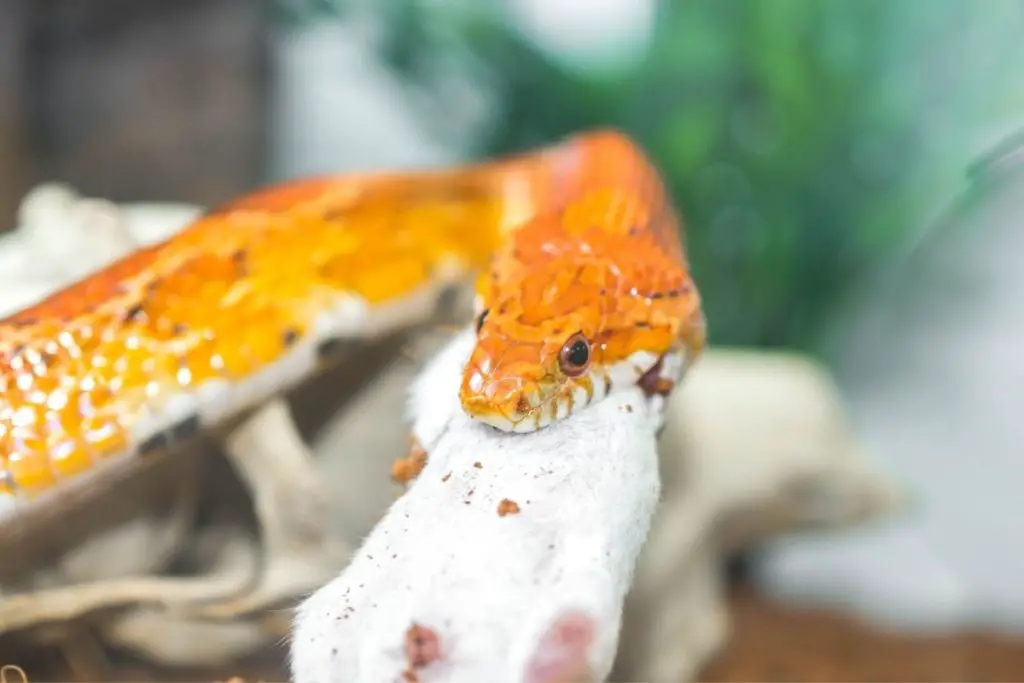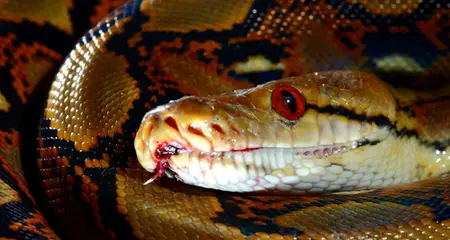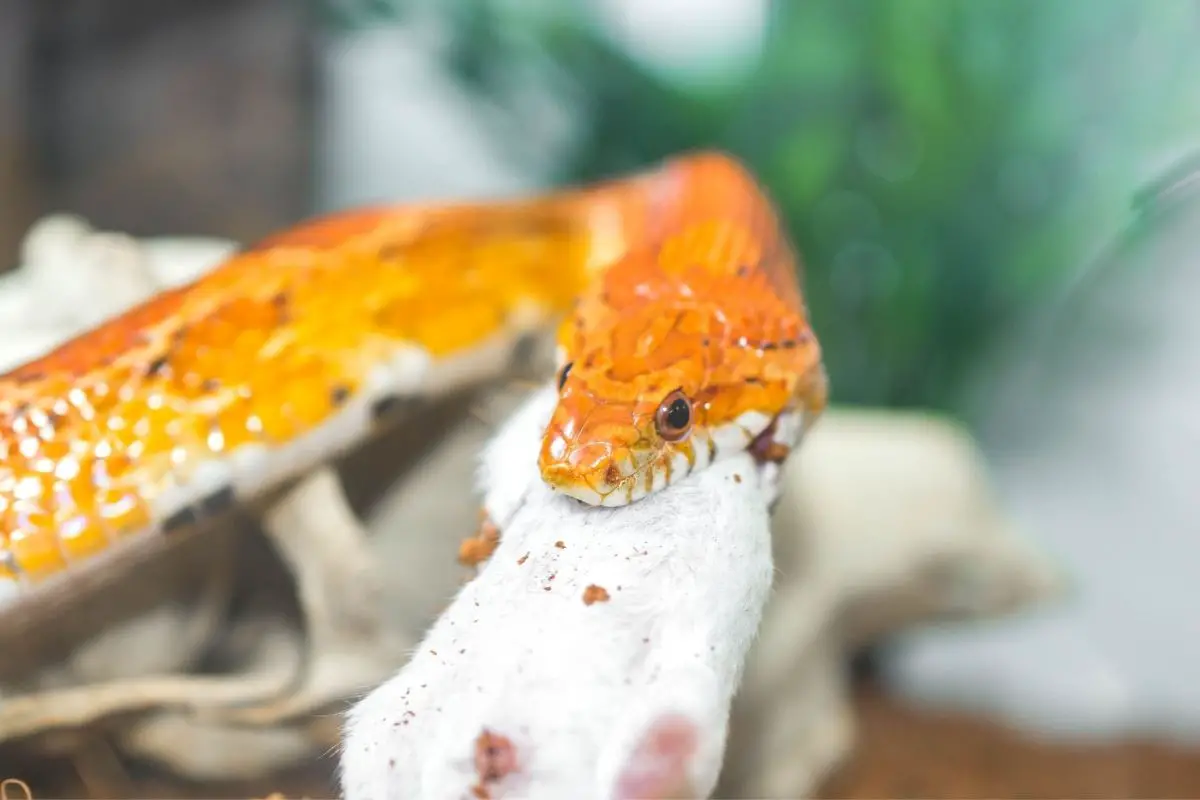You probably already know that snakes are quite different from other pets. You can’t put them on a leash, take them for walks, and they won’t communicate with you with sound or facial expressions.
But what about food? You also probably already know that your snake can go without food for quite a while, but how long can this last?
In simpler words: How long can snakes go without food? Most Snakes can go without food for a few weeks, but some snakes can go without food for up to two years. The exact period depends on their species, age, and health. Keep in mind that pet snakes will have different nutritional needs than their wild counterparts.
I know how much the “it depends” answer can be infuriating, because you just want to know about your own snake, right? Don’t worry, stick with me on this article as I do my best to try to answer all these questions (and some more).
Contents
How Long Can Snakes go without food?

There are more than 3,000 snake species worldwide, but only 20% of them are poisonous. Still, there are only a few species that you can keep as pet snakes at home.
However, before adopting one, you should understand their behaviors. Snakes’ eating habits vary considerably based on species, anatomy, and origin, among other things.
Although pet snakes can eat some human foods, you still must adhere to specific rules in order to keep your pet healthy and long-lived. Furthermore, you really need to know exactly how long your own pet snake can go without consuming food.
Here is a table with how long the most popular pet snakes can go without food:
| Pet Snake Species | How long can the snake go without eating? | Regular feeding |
|---|---|---|
| Corn Snake | 1 to 2 weeks | Once in 7 to 10 days |
| California Kingsnake | Up to 6 months | Once in 5 to 7 days in the first year Once in 10 to 14 days later |
| Children’s Python | A few weeks | Once in 7 to 10 days |
| Carpet Python | Weeks to a few months | Once in 7 to 10 days |
| Ball Python | At least 6 months | Twice a week juveniles Once in 7 to 14 days adults |
| Rosy Boa | 14 days | Once in 7 to 10 days |
| Milk Snake | 6 weeks | Once a week juveniles Once in 7 to 14 adults |
| Western Hognose Snake | 1 to 3 months | Every 5 days juveniles Once a week adults |
| Garter Snake | 2 to 3 months | Every other day juveniles Once a week adults |
| Smooth Green Snake | A few weeks | Once or twice per week |
| Cape House Snake | A few weeks | Once a week |
| Kenyan Sand Boa | Up to a year | Once a week |
| Rough Green Snake | A few weeks | 2 to 3 times a week |
Snakes can go for extended periods of time without food, but their feeding regimen is determined by a variety of things. As an illustration, let’s look at the most popular pets in the United States: Ball Python and Corn Snake.
Corn snakes are tiny, and although they require food every 7 to 10 days, starvation can kill them after an additional week or two with no ill effects.
However, a Ball Python food should only be provided once every ten to fourteen days. This huge snake can go for up to six months without food, yet its baby snakes will look for food twice a week.
You should be aware of brumation, the period of snake metabolism slowing down, when thinking about snakes’ diets.
Most reptiles will cease eating during the winter, so there’s no need to be concerned about your pet’s inactivity or lack of appetite. in fact, many people arrange special conditions at a specific time of year to enable their pets.
In the end, there’s one thing you should remember. Even though your pet snake can go without food for a long time, you shouldn’t let it go without food for more than a week. To remain healthy and flourishing, this reptile need a regular eating regimen.
What decides how long your snake can go without food?

How much your snake needs to eat, how often they need to eat, and how long they can go without eating can all change depending on various factors, and here are the most important of these factors:
Age
The age of your snake will determine how long they can without meals. Baby snakes need to eat more frequently as they need more nutrition to grow, and some of them will even need daily feeding. Larger species of snakes will usually need to be fed less. Adult snakes can go a week or more between meals.
Time (Breeding season)
Most snakes will stop eating during the breeding season, and some males will even stop eating for months or even half a year when they smell the odor of evaluating females. As for females, they will usually stop eating shortly after they lay their eggs.
Time (of the year)
Seasonal variations in temperature and food supply will have a big impact on the snake eating habits. Some species go into brumation in winter, and their feeding will come to a halt.
It appears that these reptiles have an internal clock and their metabolic rate slows down when the weather gets cold. That is why, in spite of the fact that they reside in tropical enclosures, some large snakes enter brumation to save energy during the winter.
You can learn more about brumation in my article to why snakes hibernate in houses.
Shedding
Snakes will not eat in the weeks leading up to a shed. If your pet has cloudy or milky eyes, a pink belly, or an ashy sheen, there is no cause for concern. It’s only natural to remove old skin regularly.
However, staring is another thing altogether. You can learn what are the causes your snake stare at you here to learn when you need to worry and when it’s normal.
Food
Changes in diet and feeding schedule, as well as excessive feeding, can all contribute to an eating problem in your snake. Some will also refuse to eat frozen food, rodents of insufficient size, or freshly killed animals.
If your pet stops eating, you should modify its feeding method. Remember that some species need the food they were fed before. If the snake is unable to identify the prey, it will not eat it.
Inadequate conditions
- Insufficient lighting – Some snake species prefer feeding in the dark. Because these nocturnal animals are more likely to be frightened by intense illumination, they may reject a meal if offered one in the light.
- Temperature –Snakes that live in equatorial climates will avoid eating if they are cold. Keep in mind that the ideal temperature for snakes to survive in is 65 F (18.3 C). Depending on the species, it should be between 70 and 90 degrees Fahrenheit (21 and 32 C). You can learn more about how the cold affect your snake here.
- Humidity –Inadequate humidity levels may result in respiratory illnesses, skin issues, and hunger depletion.
- Dirty terrarium – Snakes can sometimes refuse their food because of the unclean enclosure.
Stress
Snakes do get stressed, and one of the common ways snakes show they’re stressed is by stopping eating.
You can learn what are the reasons your snake may be stressed here.
Why can Wild Snakes go longer without food (than pet snakes)?

According to Marshall D. McCue and his coworkers, starvation is a natural component of snake life, particularly those who live on islands. Because food is only available during particular times of the year, these reptiles must learn to live with restricted food supplies.
Many long-term studies using radio telemetry and mark-recaptured snakes have shown that snakes’ bodily condition deteriorates with lengthy hunger periods.
The majority of them reside in a dormant state throughout the winter months, when they cease feeding and their metabolism slows down. This enables these creatures to live in the wild for a long time, regardless of the circumstances.
Despite the fact that many snakes species can survive for months, even years without food, much is still unknown to experts.
Food scarcity, for example, has never been studied in depth.
Here is a table with some of the most common wild snakes in North American and how long they can go without eating:
| Wild snake types | How long can they go without food? | Regular Eating |
|---|---|---|
| Copperhead | All winter | One meal in three weeks in summer |
| Water Moccasin (Cottonmouth) | A few weeks | Whenever they find prey. |
| Rat Snake | At least 6 months | Once every 7 to 10 days |
| Western Diamondback Rattlesnake | At least 6 months | Once every 2 to 3 weeks |
| Eastern Diamondback Rattlesnake | At least 6 months | Once every 2 weeks |
| Western Diamondback Rattlesnake | At least 6 months | Once every 2 to 3 weeks |
| Western (Prairie) Rattlesnake | At least 6 months | Once every 2 to 3 weeks |
| Mojave Rattlesnake | For weeks | Once every 1 to 2 weeks |
| Anaconda | Up to two years | Just 4 to 5 times a year |
| Python | At least 6 months | Twice a week for babies, Once every 1 or 2 weeks adults |
| Boa Constrictor | A few weeks to several months | Once in 5 to 7 days juveniles Once in 10 to 14 days adults |
Some snake species, according to biologist Marshall D. McCue’s research, may go months without eating. He was studying three snake species:
- 22 Rat snakes (Elaphe obsoleta)
- 20 Ball pythons (Python regius)
- 20 Western diamondback rattlesnakes (Crotalus atrox)
He studied how snakes adapted to food deprivation by leaving 62 snakes without food for 168 days after which monitoring their potentially adaptive strategies in coping with food scarcity. The following were the most common adaptations:
- They lowered their metabolic rates by 70% to 72%
- They reduced their energy expenditures by 80%
- They put circulating metabolites completely under control
- They increased their body length using tissue remodeling
- they prioritized mass loss in particular organs
Snakes not only survived without food during this time, but they also grew. This means these reptiles were extremely resourceful in utilizing what was accessible to them.
When they abandoned eating, these fascinating creatures started burning abdominal fat reserves in order to preserve structural protein. After that, the source of energy depended on the species.
16 Western diamondback rattlesnakes that were immature were the subject of an earlier study by the same scientist. They were fed a controlled diet for 24 weeks and, as a result, their bodies adjusted to the situation effectively.
- They reduced their plasma glucose
- They increased circulating ketones
- They increased fatty acid burning to save amino acids
He discovered a few fascinating things as well. For example, the water accumulation caused the snakes’ bodies to expand by 7 percent. Starving snakes began to digest their heart muscles after years of not eating.
Because the reduced energy demand required less circulatory demands, their hearts shrank without negative impacts.
Snakes lost 9 to 24 percent of their initial body mass at the conclusion of the study, depending on species. Their hearts were rebuilt quickly after the first feeding, which is remarkable considering how swiftly they lose weight.
According to recent research, starvation has an impact on snakes’ scales and feces, as well as the flesh of deceased reptiles. It was demonstrated that stable isotopes might be used to study famine in reptiles, including snakes.
For example, the carcasses’ isotopic composition did not show significant changes after starvation. In contrast, the scales’ isotopic signatures change slightly, while their excreta significantly alter.
My Snake won’t eat – when to worry?
If after all your efforts, the snake still won’t eat despite eliminating common reasons for refusal in pets and yet refuses food, it’s time to see an exotics veterinarian. The hard part is that no one can tell you when to be concerned since it is species-specific.
When a snake loses weight, there is typically no cause for concern. When it gets too thin, however, it is worrisome. You’ll know something’s wrong when you notice the spine that runs down the centre of its body, which is generally covered by muscles and has a ridge on top.
After six months, changes will become visible in adults, but they are not visible in youngsters. They can’t go without food for more than a month. You should look for some pathological conditions, including these more common ones:
Mouth Rotting

It’s an uncommon mouth illness that results from the immune system weakening. Improper feeding, oral injuries, and a lack of humidity or warmth in a terrarium are all possible causes.
Ulcerative stomatitis is a serious issue in captive reptile populations, particularly snakes, according to Stephen J. Divers from Elands Veterinary Clinic.
When the sanitation in a terrarium is poor, Enterobacter agglomerans can induce stomatitis in trapped reptiles, according to the study released in 2017 by Seven Mustafa and Teodora Popova.
Intestinal Parasites
Ectoparasites and helminths will affect your snake’s eating habits as well as its health. Remember that some worms are prevalent in reptiles, but their overabundance is what causes this issue.
Respiratory Diseases
Pneumonia and other respiratory diseases are common in captive snakes, and they might be a cause of a snake’s loss of appetite. In 25 snakes with pneumonia, scientists discovered 47 distinct gram-negative bacteria.
Owners frequently fail to recognize this condition until it has advanced, according to Christal Pollock, DVM, DABVP.
Can a Snake starve itself to death?
Snakes sometimes starve themselves to death if they can’t adapt to their poor living conditions and can’t escape their home. Snakes under a lot of stress can also starve themselves to death.
In a captive environment, most snakes will react to stress, low temperatures, bright light, and humidity in the cage. The initial response is to refuse to eat.
The main problem is that these heat-lacking poikilotherms can’t generate their own warmth, so they rely on external factors.
A lack of heat will cause your pet’s metabolism to become irregular, its immune system to weaken, and the snake will become lethargic.
Another is illness. So, it’s all right if your snake’s diet is halted for biological causes, but an neglected or sick animal will not begin to eat and will most certainly die of starvation.
Once you improve the environment and cure the health problem, your pet will give up hunger and start eating again.
Keep in mind that snakes can go for months or even years without eating. Still, no research has yet to show whether such changes have an impact on their bodies’ physiological functions after lengthy periods of starvation.
So be careful and don’t rely too much on the fact that they go long without food, but also don’t panic when they refuse a meal.
Conclusion
Snakes are unique creatures that have different needs when it comes to food and how long they can go without it. While some owners might think their snake is refusing to eat because of a lack of will power, the truth is usually much more complicated than that.
By understanding the various reasons for a refusal to eat, as well as the health risks associated with starvation, owners can be better equipped to handle this situation.
Remember that snakes are resilient and if given the proper care, they will eventually resume their regular eating habits.
Before you go, you should also check out this article on how long can snakes survive without water to learn how often you should add freshwater to their bowl, how to know they’re thirsty or dehydrated, and what are the less-obvious warning signs you must watch out for.
Related Questions
Can Snakes live without eating?
Snakes can not live completely without eating, but some snakes can go for up to 2 years without a meal. Snakes can survive so long without food because they can lower their metabolic rates by as much as 70% and expending so little energy.
How long can a ball python go without food?
An adult ball python can go up to six months without eating, but this is dangerous for the snake’s health.
Helpful Resources
Physiological Responses to Starvation in Snakes: Low Energy Specialists
Presenting problem: Respiratory Disease in Snakes
If you like this article, please share it!


